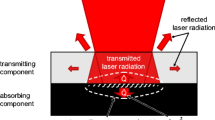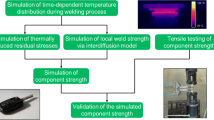Abstract
Because of several advantages, e.g., an exact and high energy input, laser transmission welding has become more and more important in the last few years. Due to the contactless energy input, a sufficient process control is a challenge. In industrial production, the process parameters for a good weld seam are qualified by the energy input, which describes the process parameters laser power, laser velocity and irradiation time. These process parameters lead to the welding temperature, which influence the weld seam quality. The question remaining is whether the energy input describes the weld strength sufficiently or whether the welding temperature has a higher influence on the weld quality. In this study, the influence of the energy input on the weld quality is determined for an industrially relevant material combination (PBT ASA-GF20 and PC) in experimental examinations for quasi-simultaneous laser transmission welding. The welding temperature for every design point is calculated and the influence of the temperature on the weld strength is analyzed in an FEM model. In order to compare the influences of the two factors, welding temperature and energy input, a correlation analysis is performed. The correlation analysis shows a higher influence of the welding temperature on the weld strength compared to the energy input. But the energy input is also able to describe the weld strength.










Similar content being viewed by others
Abbreviations
- ASA:
-
acrylonitrile-styrene-acrylonitrile
- c :
-
z-transformation
- E s :
-
energy input
- FEM:
-
Finite element method
- F ( r) :
-
Fisher-transformation
- GF:
-
glass fiber (reinforced)
- I 0 :
-
maximum intensity of the Gaussian laser beam
- \( {\overline{I}}_n \) :
-
intensity of simultaneous welding at the surface for the thermal source (\( {\dot{\phi}}_{n,1} \)) in the FEM model
- \( {\overline{I}}_n(z):: \) :
-
averaged intensity in the z-direction for the thermal source (\( {\dot{\phi}}_{n,1} \)) in the FEM model
- \( {\overline{I}}_{(x)} \) :
-
intensity of simultaneous irradiation
- K :
-
absorption coefficient
- LTW:
-
laser transmission welding
- m :
-
number of design points
- N :
-
number of scans
- n :
-
numbers of thermal sources
- PBT:
-
polybutylene terephthalate
- PC:
-
polycarbonate
- P L :
-
laser power
- p J :
-
joining pressure
- QSW:
-
quasi-simultaneous welding
- r σ, T :
-
correlation coefficient of the weld strength and welding temperature
- s :
-
range of the confidence interval (z-transformation)
- s J :
-
joining displacement
- t :
-
t value
- t :
-
process time
- t u :
-
time of one scan
- \( {\overline{T}}_R \) :
-
averaged ranked welding temperature
- T R, i :
-
ranked welding temperature of the design point i
- v s :
-
scanning speed
- w :
-
laser beam diameter
- x :
-
x-coordinate
- ∆x :
-
width of the thermal source (\( {\dot{\phi}}_{n,1} \)) in the FEM model
- z :
-
z-coordinate
- ∆z :
-
height of the thermal source (\( {\dot{\phi}}_{n,1} \)) in the FEM model
- α :
-
significance level
- ε all :
-
all strain
- ε ij el :
-
elastic strain
- ε ij pl :
-
plastic strain
- ε ij th :
-
thermal strain
- \( {\dot{\phi}}_{n,1} \) :
-
thermal source in the FEM model
- \( {\overline{\sigma}}_R \) :
-
averaged ranked weld strength
- σ R, i :
-
ranked weld strength of the design point i
References
Gotzmann G (2015) Aus dem Laserschwert wurde ein Universalwerkzeug; Kunststoffe 6/2015. Carl Hanser-Verlag, München
Horlemann S, Baudrit B, Heilig M et al (2015) Passive thermography as a non-destructive testing procedure during welding of plastics. Joining Plastics 9(2):106–113 DVS Media GmbH, Düsseldorf, (GER)
Laser LPKF & AG Electronics Qualitätsüberwachung und –dokumentation beim Laser-Kunststoffschweißen. Erlangen (GER)
Horn W (2009) A progressive laser joining method. Laser Technik Journal 1, Wiley-VCH Verlag, Weinheim
Schmaizl, Steger, Hierl (2015) Process-monitoring of Laser welding of thermoplastics, Laser Technik Journal 4, Wiley-VCH Verlag, Weinheim
Hopmann C, Poprawe R, Russek UA et al (2013) Comparison of process variants and modeling of preocesses for laser transmission welding in order to simplify the qualification and aelection of processes. Joining Plastics 3-4/2013 S:160–168, DVS Media GmbH, Düsseldorf
Kreimeier Sooriyapiragasam S, Hopmann C (2016) Modeling of the heating process during the laser transmission welding of thermoplastics and calculation of the resulting stress distribution. Welding in the World 60:777–791, International Institute of Welding, Berlin Heidelberg (GER)
Bates PJ, Okoro TB, Chen M (2014) Thermal degradation of PC and PA6 during Laser transmission welding. International Institute of Welding, 67th Annual Assembly, Seoul (KOR)
Potente (2004) Fügen von Kunststoffen. Carl Hanser Verlag, München
Ehrenstein GW (2004) Handbuch Kunststoffverbindungstechnik. Carl Hanser Verlag, München
Fiegler G (2007) Ein Beitrag zum Prozessverständnis des Laserdurchstrahklschweißens von Kunststoffen anhand des Quasisimultan- und Simultanschweißen. PhD Thesis, University of Paderborn, Paderborn (GER)
Wilke L, Schoeppner V, Potente H (2007) Weld quality in dependence of energy for the quasi-simultaneous welding process. International Institute of Welding, 60th Annual Assembly, Dubrovnik (CRO)
Wilke L, Potente H (2007) Comparing laser transmission principles, 65th Annual Technical Conference of the Society of Plastics Engineers (ANTEC), Cincinnati (USA)
ABAQUS 6.12 User’s Manual: Volume 3, Dassaults Systems Simulia Corp., Providence RI (USA) (2012)
Wittel (2010) FEM for 4 - Eine kurze Einführung in die Finite Elemente Methode. ETH Zürich, Institut für Baustoffe, Rechnergestütze Physik der Werkstoffe, Zürich
Livemore Software Technology Corporation (2012) Hourglass (HG) modes, Las Positas Rd, Livermore, (CA)
Engelhard Spearman-Korrelation/Rangkorrelation, online-reference: http://www.crashkurs-statistik.de/spearman-korrelation-rangkorrelation/, Retrieved on 23.06.2016
Rasch, Friese, Hofman et al (2004) Quantitative Methoden 1. Springer Medizin Verlag, Heidelberg
Author information
Authors and Affiliations
Corresponding author
Additional information
Recommended for publication by Commission XVI - Polymer Joining and Adhesive Technology
Rights and permissions
About this article
Cite this article
Lakemeyer, P., Schöppner, V. Simulation-based investigation on the temperature influence in laser transmission welding of thermoplastics. Weld World 63, 221–228 (2019). https://doi.org/10.1007/s40194-018-00696-8
Received:
Accepted:
Published:
Issue Date:
DOI: https://doi.org/10.1007/s40194-018-00696-8




